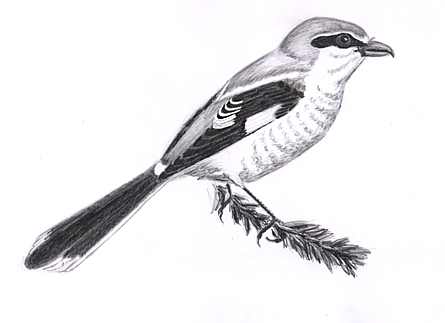
Dear Bird Folks:
I was telling someone about a mockingbird that hangs out in my neighborhood. The person replied by saying that I should look closely at all mockingbirds this time of year. I might be lucky enough to see a “butcher bird”. I thought “lucky, butcher, huh?” What is a butcher bird and what does it have to do with my mockingbird?
– Steven, Plymouth
Wow Steve,
A question from Plymouth, America’s Hometown. Cool beans! I knew this day would come sooner or later. Although I’ve always envisioned the question from America’s Hometown being about the patriotic Bald Eagle, not the butcher bird. This question sounds more like it should come from Amityville.
The more common name for a butcher bird is a shrike. Shrikes do indeed look like mockingbirds and I’m sure many of them go unnoticed as most people mistakenly think they are seeing mockers. Shrikes are fairly rare around these parts and it is well worth taking a second look at any wintering mockingbirds in hopes of seeing one.
North America has two species of shrikes, the Loggerhead Shrike that is mostly seen in the south and the Northern Shrike that is found in, of all places, the north. The Northern Shrike breeds way up in northern Canada. In the winter they become a bit nomadic and push their way south, sometimes making it to New England, Cape Cod and of, course, America’s Hometown.
So why do we call something that looks like the beloved mockingbird a “butcher bird”? Why would a songbird be given such a nasty name? It is because shrikes eat their fellow songbirds. From a distance it may look like a harmless songbird, sitting on an exposed branch, sunning itself in the midday sun. Then suddenly the bird will take flight and knock another bird out of the sky. The shrike will then pounce on the fallen bird, smash the victims skull with its beak and eat it for lunch. As grizzly as this sounds, that is not the reason why shrikes are called butcher birds. It gets better.
Shrikes not only kill other birds for lunch, they kill other birds for a luncheon later on in the week. A shrike that is too full to eat will keep killing any prey that comes across its path, to be consumed later. They are one of the few birds to perfect the concept of leftovers. Freshly killed prey is carried off to be impaled on a sharp stick or thorn or wedged in a fork of a branch. Shrikes will even impale their prey on the spikes of a barbed wire fence. Anthropologists recently have credited shrikes for inventing the popular Mediterranean dish, shishkabob.
A shrike’s cache can look pretty grim. A small pricker bush can have an assortment of dead creature hanging from it. In addition to birds, shrikes will hang-up mice, lizards, crickets and the occasional Twinkie.
The theory is that shrikes store food for times when hunting isn’t so good. That makes sense for birds that live up north where there are long periods of snow. The same reasoning doesn’t hold up for the birds that live in the south, but that’s the best we can come up with for now. Like most birds of prey, shrikes regurgitate pellets. Pellets are filled with anything that can’t be digested, like small bones, feathers and Twinkies. Pellets are a good clue that a shrike is in the area.
Yes Steve, you should look at every mockingbird closely. If you happen to find one with a black mask and a thick hooked bill, you are one of the lucky ones to find the infamous butcher bird. Step back and watch it for a while. You could be in for an interesting though perhaps gruesome treat. But don’t worry, it won’t attack you, unless that’s a Twinkie in your pocket.